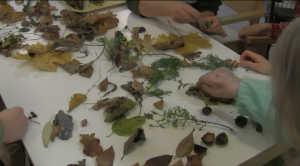International students developed this idea for an imaginative dialogue with elderly people in care homes during the intensive week in Helsinki, 2021
By Anton Logi Ólafsson, Anja Nilsen, Wilhelmina Ojanen and Marja Huurdeman

In Short:
We bring nature inside. In the Netherlands, it is usual to make an autumn table at school. Pupils collect natural materials, such as coloured leaves, moss, twigs, chestnuts, acorns, beech nuts, pine cones and take it to school. There, it is laid out on a table and used for crafts by additions such as clay and cocktail sticks. It is a start to learning all about autumn.
Set-Up:
- Start with a film (Blueberry Island)
- Our objects, we found in the forest, on the table
- Take time; let the people look/feel/smell
- Making memories, remember
- Making a composition together
- Make some figures of clay
Additional options:
- Meditation > feel being into nature
- Move with nature (leaves, branches)
- If possible, we go outside
Timeframe:
1 – 1 ½ hour.
Participants:
A group of eight to ten
Process:
Making plans. Our common interest is nature and we wanted to do or make something together with the elderly. Ideally, we would go outside with them, but we did not know their living environment and condition. So we explored the possibilities of bringing nature inside. Marja introduced the autumn table. That was a good idea, moreover doable to realise in a short time. Wilhelmina knew a beautiful nature area nearby. Making a film about the area served two purposes: to record our activities and as an introduction for the workshop.
Collecting materials. We went to Blueberry Island to collect natural materials and make film recordings. In addition, we bought two packs of clay in town. unfortunately, Wilhelmina fell ill, she could not come with us, but fortunately she was able to edit the film.
Workshop for elderly people on the location.
Somewhat uncomfortably, the residents with walkers or wheelchairs enter the living room and sit down at the large table. One very interested in who we are and curious about what is to come, another startled at any unexpected movement, yet another firmly holding the carer’s hands. Lots of repetition in spoken language. We introduce ourselves using name stickers, which already breaks the ice. We tell them we went to Blueberry-island yesterday and made a film there. We will watch that together. They watch it quietly, satisfied but also resigned. At the little birds, they get happier.
Then we tell them that we have collected things and taken them with us. We put some things on the table and explore things together with the residents. It is not difficult at all to get them to join us, looking at leaves, polishing up shiny chestnuts, feeling smooth, rough and prickly, arranging and stacking. The wet stuff then also gets on the table, which turns on the sense of smell. One man is very fascinated by the pebbles, he looks at them intently, lining them up and stacking them. There is laughter, over-throwing of chestnuts, and friendly communication. As a final action, we introduce the clay. It is difficult to shape the clay with weak hands and fingers. Small pieces, warming well and pre-kneading helps, but we mainly make presents: reindeer from chestnuts, mushrooms, little birds from clay and maple wings. It is fantastic to witness, how people become enthusiastic and actively participating. The natural materials activate memory, through touch, smell and play. And we did it together! The imaginative dialogue was more than successful.
Principle:
Dialogue in English with old people, who can no longer express themselves so easily because of dementia, is challenging. With words, we cannot understand each other. Using images and tangible materials works better. By creating together, there is interaction. Materials from nature require using all the senses. All sensory experiences together, evoke memories. Nature provides recognition , is familiar and makes playful.
Variations:
Materials from nature always capture the imagination. For both children and the elderly, it is a start to storytelling. And with it, a dialogue can be initiated.
Connection to PIMDI:
Imagination is about dreaming
Imagination is about memories
Imagination is a very strong start for a dialogue
A dialogue brings differences together to a new imagination
